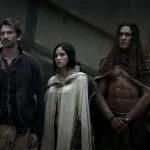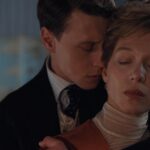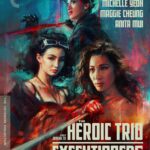A Series of Crimes: Bonnie and Clyde, by Aaron Pinkston
Bonnie and Clyde has become known as a complete game changer in Hollywood. Its release signified the end of the old and the start of the New Hollywood — a film era that allowed filmmakers to take visual risks and tell stories outside the norm. Arthur Penn is a strange figure to shepherd in this era. As a director mostly known for television and The Miracle Worker up to this point, he didn’t seem to quite fit the mold of the 1970s rebel filmmaker. But what better film to establish this period than one literally about characters who gleefully break all the rules? Coincidentally (or not) Bonnie and Clyde is also a game changer for this crime film series, distinctive in its period, overt rebelliousness and, of course, views on gender and sexuality.
Surprisingly, this is the first film I’ve tackled that is a period piece, not set in its contemporary time, and so it reflects both eras. Really, Bonnie and Clyde is stuck between three eras: the depression-era 30s in which it is set, the rebellious 60s signified by the conflict in Vietnam, and the time of the American West outlaws. During this viewing of the film, I was struck by how much Bonnie Parker and Clyde Barrow are influenced by and how much the film views them as mythic figures only seen in the wild west. The famous quote from The Man Who Shot Liberty Valance comes to mind: “When the legend becomes fact, print the legend.” The real-life outlaws became an American sensation because their adventures became daily fodder for the press — none of their exploits were inherently history worthy, but once they become mythologized in the culture, they became something else. This takes the inherent interest the audience has in criminals to a tangible level. Clyde remarks at one point that the papers all exaggerate; that if they really pulled off everything they said they have, they’d be millionaires. The film does its own fair share of myth-making of these characters, especially in the famous hyper-real death scene that is both horrific and legendary. Bonnie even verbalizes their link to the folk heroes of the West in her poem at the end of the film, equating their story with Jesse James.
This hero worship plays directly into the film’s setting. Like last week’s heist film, Odds Against Tomorrow, the bank is the enemy. Because of the Great Depression period, when thousands were losing their homes and businesses because they couldn’t pay the banks, Bonnie and Clyde were just the people who could stand up to them. When they come across one unlucky chap, this idea becomes a bit of a revenge fantasy, with the old man shooting a gun at the repossession notice. Clyde’s credo throughout the film is extremely important. He identifies themselves by saying “We rob banks,” not “We rob general stores and gas stations,” even though they do that, too. By saying “We rob banks,” he is saying “I’m on your side.” The bank is a special place that signifies what is wrong with the world, so when they directly take on the banks, thousands of people who have come to hate this institution can’t help but rejoice.
And even still, Bonnie and Clyde is a crime film made about the ultimate rebels during America’s most rebellious time. The pair not only hate the banks, but all institutions, including the police. They don’t see eye-to-eye with the police because they are outlaws on the run, sure, but they seem to revel in making the police look bad. This attitude fits right in with anti-Vietnam sentiment. They might not be flower children, but if these characters lived in the late 1960s, they would probably do everything they could to dodge the war. Not because they are against the war – just because. It’s not a mistake that they finally meet their end only after (and so soon after) they become more of a normal couple by finally consummating their relationship and start talking about marriage as a possibility. Just as soon as they lose their rebelliousness, their status in this world is broken.
This film also notes the first actual female criminal of the series (you could make a case for Ma Jarrett in White Heat, but Bonnie Parker is more definitive). As one would expect, women aren’t typically treated very well in this genre — they are mostly either worshiped mothers or complicit molls. Either way, women have little effect on the narratives of these films, and what little they have is completely in how they serve the manly men. It is typical for the female protagonists to be sympathetic, but not in a positive way. More times than not, their relationship with the criminal gets him closer to his final doom. With Bonnie and Clyde being the first film here to consider the female criminal, it begs the question as to what the role for women in the crime film. When the woman is the prominent criminal, does that break down society even more? Bonnie Parker is a particularly interesting case, because she fulfills so many roles in this film, at times playing both the positive and negative elements of female portrayals.
Is Bonnie Parker a feminist icon? This is a very difficult question to answer. There are clear argument for yes and no, almost in equal measure. She’s certainly not Susan B. Anthony or Betty Friedan, but she’s a smart and independent woman. Women’s roles in society were at their most turbulent in the film’s two major eras — just after the 19th amendment giving women the right to vote and around the rise of a new radical feminism.
In many ways she controls the central relationship. Before they meet, Clyde Barrow is a criminal, but he can’t be the legend unless Bonnie is by his side shooting along with him. In the same way, she can be seen just as a figment to fix Clyde, both as a criminal and as a man. Bonnie also has agency, something which nearly all women in this world have previously lacked — she ultimately decides that this life on the run is the life for her, and not just because this is how she can get a man.
Her sexuality also is played both ways. Bonnie is literally introduced through her sexuality. The very first image of Faye Dunaway in the role is a close up of her sultry red lips and then her naked back. She’s playful and promiscuous from the start — before we know much about this character she is played as an object of desire. But she knows how to work her sexuality and uses it against Clyde immediately. When Clyde shows her his gun, she fondles it with glee, tempting him to prove his manhood by robbing a nearby store. Throughout the film, as Clyde’s impotence becomes clear, Bonnie expresses her sexual wants and desires. In that way she isn’t really the object of desire but a willing and needful participant.
Bonnie and Clyde is a truly a landmark film, made complex by its crossing of eras and sexual politics. It isn’t a difficult film to read, but there are so many points of readings that can be considered. The truth, though, is that crime films would be changed from this point out, becoming more sinister and violent, with criminals capable of much more. For most of the remaining films in this series, the criminals aren’t the James Cagney-type hero, but the anti-hero, pushing the boundaries further than ever before.





























